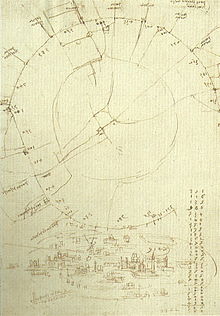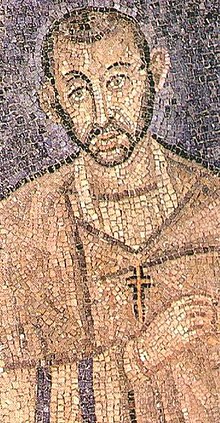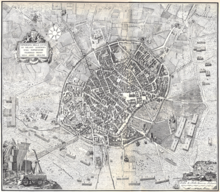History of Milan
This article covers the history of Milan from ancient times to the present.
Antiquity
The history of Milan goes back to ancient times. The ancient Mediolanum was the most important city in Gallia Transpadana . Livy attributes its founding to the Insubrians under Bellovesus after their defeat against the Etruscans at the time of Lucius Tarquinius Priscus . The name of the city is of Celtic origin. The Romans defeated the Insubriates 225–222 BC. And stormed Mediolanum the following year. Its residents rebelled some 20 years later during the Second Punic War , but were defeated and finally in 196 BC. Completely subdued.
They acquired 89 BC Chr. The Latin citizenship and 49 v. Full civil rights, as well as the inhabitants of the other cities in Gallia Transpadana. Later (but not before the 2nd century) Milan seems to have become a Colonia . In Strabon's time, Verona was as important as it was, but smaller than Patavium . Only gradually did their importance grow.
Towards the end of the 3rd century Mediolanum became the seat of the governor of Aemilia and Liguria (which at the time also included Gallia Transpadana), from the end of the 4th century only that of the governor of Liguria , while Aemilia got its own governor. The Praefectus praetorio and the imperial vicar had their seat here since Diocletian's time . With the Diocletian imperial reforms (286 AD), Milan became one of the imperial residences of the Roman Empire.
During the 4th century, the emperors of the Western Empire also resided in Mediolanum until Honorius preferred Ravenna and moved his court there in 402. Prokopios of Caesarea names the city as the most important in the west after Rome and reports that when it was captured by the Goths in 539, the city was razed to the ground, 300,000 men capable of weapons were killed and the women enslaved. It was an important traffic junction, with roads (corresponding to today's railway lines) to Comum , to the Lacus Verbanus , to Novaria and Vercellae , to Ticinum , to Laus Pompeia and on to Placentia and Cremona as well as Bergomum .
Secular power corresponded to the independent position that the Church of Milan held at the time of Ambrose - Bishop of Milan 374–397 - who baptized Augustine here in 387 . The power of the bishop was shown, for example, in the act of penance he had Theodosius I perform for the massacre of the inhabitants of Thessaloniki .
Migration period
After the death of Theodosius I, the period of the Great Migration began (see late antiquity ). Milan felt the attacks of the Huns under Attila (452), the Heruli under Odoacer (476) and the Ostrogoths (539). When the Eastern Roman general Belisarius was sent by Justinian to re-conquer Italy, the Archbishop of Milan, Datius, allied with him and the Goths were driven out of the city. But Uraias, nephew of the Gothic king Witichis , took the city again. Uraias completely destroyed Milan in 539, so that the city, once a center of Roman civilization, now has hardly any remains of antiquity.
The Eastern Roman general Narses (allegedly) asked the Lombards for help on his campaigns against the Goths . In any case, they came under their King Alboin in 568 and soon ruled large parts of northern Italy. They invaded Milan the next year, but made Pavia their capital. They gave the central region in Northern Italy their name: Lombardy .
Development to the Comune
After the Lombard capital was founded in Pavia , Milan remained the center of the Italian opposition to foreign rule. The Lombards were Arians , and the Archbishops of Milan had always been Orthodox from the days of Ambrose . With their opposition stance, the bishops gained great influence among the people and were gradually able to acquire military, executive and judicial power in addition to their spiritual authority. They exercised this power through their delegates, who were called visconti .
When the Lombard kingdom fell under Charlemagne , the Frankish king , after the Pope's appeal for help in 774 , the Archbishops of Milan were further strengthened by the close alliance between Charles and the Church, which gave them some sort of confirmation of their temporary authority, and also through Karl's policy of subdividing the great Lombard fiefs and duchies, which he replaced with smaller districts. Under the confused government of Charles's immediate successors, the archbishop was the only real power in Milan. But there were two kinds of difficulties in the situation, ecclesiastical and political; and its existence had a marked impact on the development of the people and the growth of the commune, which was the next stage in the development of Milan.
Charlemagne received the imperial crown from the Pope in the year 800 because of his commitment. His son Pippin took over the rule of the new Regnum Italiae .
On the one hand, the archbishop had to fight against the heretics or against fanatical reformers who found a following among the people; on the other hand, emperors, nobles and the people wanted him on their side, for he was the only power in the city. Whichever party he belonged to, the other two always opposed him. For these reasons it sometimes happened that there were two archbishops and therefore no central authority, or no archbishop at all, or even an archbishop in exile. The main result of these difficulties was that a desire for independence and the ability to judge and act for themselves developed among the people of Milan.
The terror of the Hungarian invasion in 899 helped the Milanese on their way to freedom, forcing them to take up arms and fortify the city, making Milan more independent than ever from feudal lords who lived in their castles in the countryside. The tyranny of these nobles drove the peasants and minor vassals to seek protection for their lives and property, as well as equality in taxation and justice. They could only find this within the city walls and under the rule of the archbishop. In this way Milan's population grew and learned to govern itself. Its inhabitants first became "Milanesi" under the flag of Sant'Ambrogio; they were no longer subjects of a foreign conqueror, but an individual people, with a city life and their own interests.
High Middle Ages
In 1157 an almost circular moat was built around the city, which is still preserved as an inner canal or Naviglio. But in 1162 Friedrich Barbarossa took the city and almost completely destroyed it, sparing only a few churches. However, the city with its walls was rebuilt five years later by the allied cities of Bergamo , Brescia , Mantua and Verona .
After the victory over Barbarossa in the Battle of Legnano in 1176, the Lombard cities fell into disagreement again, but Milan began to gain material prosperity again. After the Peace of Constance in 1183, the city walls were expanded and trade flourished. During this time, the irrigation work began, which significantly improved agriculture in the Lombardy plain.
The government of the city consisted of a) a Parlamento or Consiglio grande , which was gradually reduced to 2000, 1500 and finally 800 members, b) a credenza of twelve members, elected by the Parlamento and dealing with urgent or secret matters, c ) the consuls, who were elected as executive for one year and had to report to the parliament at the end of their term of office.
Torriani and Visconti
In a bitter rivalry between nobility and people, two noble families gained importance as protagonists of the warring parties: the Torriani or Della Torre from Valsassina , and the Visconti , who derived their name from the office of delegate they had held under the archbishops. After the Battle of Cortenuova in 1237, in which Frederick II defeated the Guelph army of the Milanese and captured their Carroccio , Pagano della Torre gathered and rescued the surviving Milanese scattered around. Popularized by his behavior, he was appointed to the government.
His task was initially limited to the catasta, a property tax that was levied equally on all citizens. This democratic measure was characteristic of the party to which he belonged and made it hated by the nobility. Pagano died in 1241, and as Podestà he was followed in 1256 by his nephew Martino, who in 1259 bore the title of Signor for the first time in the history of Italy .
The nobles led by the Visconti threatened to bring Ezzelino da Romano , the Ghibelline tyrant of Padua, into the city, but were defeated by Martino, taking 900 of them prisoner. Martino was followed by two more Torriani, his brother Filippo (1263–1265) and his cousin Napoleone (1265–1277) as lords of Milan. Napoleone received the title of Imperial Vicar from Rudolf von Habsburg . But the nobility under the Visconti had steadily grown in power, and Napoleone was defeated at Desio in 1277. He ended his life in a wooden cage in Castel Baradello above Como .
Rule of the Visconti
Ottone Visconti , Archbishop of Milan (from 1262), the victor of Desio, became master of Milan and founded the House of Visconti , which ruled the city until 1447 - except for the period from 1302 to 1310, when Guido della Torre ruled there. Ottone (1277-1295), Matteo (1310-1322), Galeazzo (1322-1328), Azzo (1328-1339), Luchino (1339-1349) and Giovanni (1349-1354) succeeded one another. Giovanni passed the rule on to three nephews: Matteo , Galeazzo and Bernabò . Matteo was killed in 1355 by his brothers, who divided the Milanese among themselves, Bernabò ruled Milan (1354-1385), Galeazzo in Pavia (1354-1378).
Galeazzo left behind a son, Gian Galeazzo Visconti , who became the sole ruler by imprisoning his uncle Bernabò. Under him the construction of the Milan Cathedral and the Certosa di Pavia began. He was the first to receive the title of Duke of Milan from the Roman-German King Wenceslaus in 1395 . He was followed by his sons Giovanni Maria , who ruled in Milan (1402–1412), and Filippo Maria , who ruled in Pavia (1402–1447). When his brother died in 1412, Filippo Maria united the entire duchy under his government and tried to expand the territory, but failed.
Rule of the Sforza

After Filippo, the Visconti family had no male descendants. After his death the republic was proclaimed, which lasted three years. In 1450 Francesco I. Sforza , who married Filippo's only daughter Bianca Visconti, claimed the rule and obtained it by military means. Under him the Castello was rebuilt and the Martesana Canal, which connects Milan with the Adda , and the hospital were built.
Francesco was followed by five other Sforza members. His son Galeazzo Maria (1466-1476) left a minor son, Gian Galeazzo , whose guardian and uncle Ludovico (il Moro) usurped the duchy (1479-1500). Ludovico was 1500 by Louis XII. captured by France, and Milan remained under French occupation for twelve years. In a partial agreement after the Battle of Ravenna (1512) Ludovico's son Massimiliano Sforza , a protégé of the emperor, was raised to the throne and defended him with the help of the Swiss until 1515, when Francis I of France took the Milanese in the battle of Marignano conquered again, whereupon Massimiliano surrendered power in exchange for a pension from France.
Spanish rule
When Charles V followed Emperor Maximilian , he denied possession of the Milanese to Franz. In 1522 the imperial troops marched into Milan and proclaimed Francesco II Sforza (Ludovico's son) as duke. With Francesco's death in 1535, the Sforza house died out. From now until the War of the Spanish Succession (1714), Milan was dependent on Spain . Under the governor Ferrante I. Gonzaga , the city walls of Milan were expanded as bastion fortifications in line with the then modern war technology .
Austrian rule and independence movement
After the end of the war, Milan became part of the Austrian Empire and remained in its possession until Napoleon's Italian campaign in 1796.
Milan played an important role in the Italian independence movement . With the uprisings called Cinque giornate (March 18-22, 1848) it opened the revolution of 1848, in which the Austrians were temporarily expelled. Through the campaigns in Lombardy in 1859, especially the battles of Solferino and Magenta , Milan finally became part of the Kingdom of Italy .
From the Kingdom of Italy to the present
As a result of industrialization , the city grew rapidly through immigrants from other parts of the country, especially from rural northeast and southern Italy, and developed into one of the early strongholds of the labor movement . Since 1914 the socialists have appointed the mayor. After the First World War, the fascist Fascio di Combattimento ( Squadristi ) was founded in Milan in 1919 . In 1922 Benito Mussolini began his march on Rome from Milan , with which the fascist dictatorship in Italy began, under whose rule in Milan a. a. 1931 the new train station Milano Centrale was inaugurated. During Fascism there was also strong resistance here , especially after the Italian Social Republic was proclaimed as a puppet regime of Nazi Germany in northern Italy in 1943 . During the Second World War , the city suffered severe damage in 1944, and in particular achieved notoriety for the accidental bombing of a primary school in the Gorla district by the American 451st Bombardment Group , in which 186 students and teachers were killed. The rubble mountain Monte Stella in the northwest of the urban area was created from the rubble of the destroyed houses . After Benito Mussolini's escape and execution by communist partisans , his body was put on public display on April 29, 1945 in Piazzale Loreto . Since then, Milan has been known for anticipating phenomena that would appear in other parts of the country a few years later. Gaetano Salvemini coined the words: "Quello che oggi pensa Milano, domani lo penserà l'Italia." ("What Milan thinks today, Italy will think tomorrow.").
In the post-war period, Milan, like the rest of Italy and Western Europe, experienced a renewed economic boom, the Italian miracolo economico ("economic miracle"). True to its reputation for experiencing political tensions particularly early and particularly violently, Milan was also the center of clashes between revolting students and state power and between the opposti estremismi, i.e. communist and fascist , during the period of the 1968 movement and the politically troubled 1970s Youth groups. In 1969 the never completely cleared up, but probably right-wing terrorist bomb attack on the Piazza Fontana occurred here . In the 1980s, however, the city developed the reputation of a quiet, bourgeois and economically prosperous metropolis. This is also where the rise of the construction and media entrepreneur Silvio Berlusconi , who was Italian Prime Minister three times between 1993 and 2011, began.
In the 20th century, Milan grew very quickly as a result of industrialization. In the 1950s and 1960s in particular, many millions of Italians, especially from southern Italy, moved to Milan and its hinterland . From 1971 to 2001 the population of the city itself fell drastically from the previous high of officially approx. 1,732,000 inhabitants to 1,256,000. This decline can be explained with the migration of residents to the immediate vicinity, mainly due to the high property prices in the city, but also with the practically unchanged city limits despite an almost continuous transition to the (around 50) growing suburbs, those of the province, however does not belong to the city of Milan. Since 2001, Milan itself has also seen slight population growth again.
literature
- Storia di Milano , ed. by Aldo De Maddalena. 18 volumes (volume 18 Il Novecento in three parts). Istituto della Enciclopedia Italiana, Rome 1995–1996 (reprint of the 1953–1966 edition for volumes 1–17)
- Hartmut Leppin among others: Milan. In: Real Lexicon for Antiquity and Christianity . Volume 23, Hiersemann, Stuttgart 2010, ISBN 978-3-7772-1013-1 , Sp. 1156-1202






